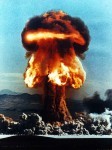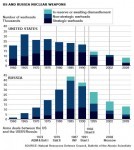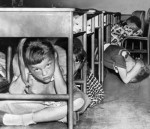
Cold War tensions and paranoia were underpinned by the fear of nuclear war. A nuclear weapon is an explosive device that derives its power from nuclear reactions called fission or fusion. These weapons are capable of enormous destructive power, thousands of times greater than that of conventional explosives. The United States was the first nation to construct and test nuclear weapons. After the bombing of Japanese cities Hiroshima and Nagasaki in August 1945, the US remains the only nation to have used them in war. America’s nuclear weapons program, the Manhattan Project, began in 1942 under the guidance of Dr Robert Oppenheimer. The first American nuclear device, the ‘Gadget’, was test-fired in mid-July 1945. These weapons generated heat, energy and destructive power that was unparalleled in human history. Even a small nuclear weapon, like the 18-21 kiloton devices detonated over Japan, had the capacity to destroy a major city. The effects of these terrifying weapons included flash-blindness, devastating blast waves and temperatures up to 10,000 degrees Celsius. Anyone who survived the initial blast of a nuclear weapon also faced the risk of fallout (radioactive particles dispersed by the weather), radiation sickness and, in the long term, cancers and other diseases.
The Soviets initiated their own nuclear program almost three years before the bombing of Hiroshima. Soviet agents in America learned of the Manhattan Project as early as 1941. This information was passed to Moscow, which ordered research into nuclear weapons the following year. In 1945, Soviet spies obtained information of immense importance: American diagnostic plans and blueprints for a nuclear weapon. Access to these plans meant the design and development of Soviet nuclear technology could be fast-tracked. In August 1949, the Russians detonated their first prototype nuclear weapon. Code-named ‘First Lightning’ by the Russians and ‘Joe 1’ by the Americans, it was similar in design, appearance and yield to the ‘Fat Man’ bomb that had decimated Hiroshima.

Within six years Soviet nuclear physicists had test-fired several nuclear weapons, each more elaborate and powerful than their predecessors. In 1955, they air-dropped a hydrogen bomb with a yield of 1.6 megatons, capable of utterly destroying a city of one million people. Both the US and the USSR also had sizeable missile programs, which used parallel technology to their research into space exploration. By the late 1950s, both countries had developed intercontinental ballistic missiles (ICBMs), a frightening new technology that allowed the long-range delivery and detonation of nuclear warheads. ICBMs were more cost-effective than aircraft and, unlike bombers, they were almost impossible to intercept. They were also considerably faster: an ICBM could be launched into sub-orbital flight from a missile silo and hit targets halfway around the globe in less than 45 minutes. Shorter-range missiles could be launched from battleships and submarines, which reduced response times even further.

The Soviet atomic tests of the early 1950s heralded the beginning of a nuclear arms race. This became the most frightening aspect of the Cold War. The US and USSR invested heavily in their nuclear weapons programs, in part because neither superpower had an accurate idea of the nuclear arsenal of the other. American policy-makers suggested there were shortfalls between its own arsenal and that of the Soviets. This so-called ‘bomber gap’ and ‘missile gap’ led to the stockpiling of large amounts of nuclear devices. By 1962, America had almost 7,000 nuclear warheads, in comparison to Soviet Russia’s 500 warheads. American nuclear weapons production eased during the mid-1960s, while older weapons were decommissioned. By 1970 the US had just under 4,000 nuclear warheads, almost half the amount from a decade before. Instead of increasing their stores of nuclear weapons, US military planners focused on new and more efficient ways of delivering them.
“But what about the Russians? Every time the Pentagon needs more money, the Russian spectre is called up. The reality is that if both superpowers, together with the lesser powers, continue on this mad spiralling arms race, building more and more atomic weapons, sooner or later they will be used. We cannot trust in the sanity and stability of world leaders. Someone must make the first move away from death and toward life… I believe the Russian people are so frightened of nuclear war that they would heave a momentous sigh of relief and would want their own leaders to follow America’s moral initiative toward disarmament.”
Helen Caldicott,
anti-nuclear activist
The Soviets, in contrast, increased nuclear weapons production through the late 1960s and 1970s. Moscow opted for size rather than quantity, ordering a greater number of strategic weapons (high-yield nuclear warheads for use against enemy cities or installations) than tactical devices (small nuclear-tipped weapons for battlefield use). In 1962 the Russians tested Tsar Bomba (‘king of bombs’), the largest nuclear device ever detonated. A hydrogen bomb eight metres in length and weighing 27 tons, Tsar Bomba was detonated over an island in remote northern Siberia. It had an explosive yield of 50 megatons: 1,400 times more powerful than the ‘Fat Man’ device that devastated Hiroshima and ten times the strength of all explosives fired by all countries during World War II. In the mid-1970s, the total megatonnage of Soviet nuclear weapons exceeded that of the US, however, the Americans had double the number of individual nuclear devices.
The United States and the Soviet Union were not the only countries to develop and manufacture nuclear weapons. Other entrants to the ‘nuclear club’ during the Cold War included Britain (1952) France (1960) China (1964) India (1974) Israel (late 1970s) and South Africa (early 1980s). The spread of these weapons to other nation-states, dubbed nuclear proliferation, was a great concern during the Cold War. In addition, several member-states of NATO – including West Germany, Canada, Belgium, Greece and Italy – had access to American-made weapons under NATO’s ‘nuclear-sharing’ arrangement. Some countries, such as Australia and Japan, undertook research into nuclear weapons and possessed the technology and resources to construct them but chose not to.

The acquisition of nuclear weapons by both superpowers led to a strategic doctrine called ‘mutually-assured destruction’. MAD, as it was aptly known, was based on the idea of reciprocation. It was common knowledge that American and Soviet nuclear firepower was capable of utterly destroying the other – and if one launched a nuclear attack, the other would detect it and respond with a nuclear attack of similar force. Proponents of MAD argued that launching a nuclear attack was akin to signing your own country’s death warrant, so this served as a deterrent to nuclear aggression. There was never a nuclear exchange between the US and the USSR so MAD seems to have been effective – but it was a risky policy. It was most fragile during moments of tension and potential confrontation, such as the 1962 Cuban missile crisis. After the Cold War, it was revealed that American and British military commanders were authorised to use tactical nuclear weapons, should war break out with the Soviet Union. On the other side, Soviet orders determined that any nuclear attack on its forces would legitimise a full-scale nuclear response.

The threat of nuclear war between America and the Soviet Union was a constant source of fear and paranoia during the Cold War. It coloured political rhetoric (in 1956 Soviet leader Nikita Khrushchev famously told European ambassadors that “We will bury you!”) and Cold War propaganda. Nuclear paranoia also shaped domestic policies, affected civilian life and permeated popular culture. Local governments in both countries developed and advertised precautions and responses for a nuclear strike, such as air-raid sirens, public shelters and emergency procedures. American civilians and schoolchildren were taught to ‘duck and cover’ in the event of a nuclear flash. Some citizens installed underground air-raid shelters in their homes, complete with food stockpiles and equipment to ‘sit out’ long periods if radioactive fall-out made the ground uninhabitable. The likelihood of nuclear warfare spawned protest movements and ‘doomsday cults’. Fears of nuclear war were expressed in art, poetry and song, from Barry McGuire’s 1965 Eve of Destruction to Sting’s 1985 Russians.

1. Nuclear weapons are explosive devices of enormous destructive capacity. They draw this power from nuclear reactions. The first nuclear weapons were developed, tested and used by the US in 1945.
2. The US detonated two nuclear weapons over Japan in August 1945. Meanwhile, Soviet spies had infiltrated the US nuclear program. This allowed the USSR to test its first nuclear weapon in 1949.
3. During the 1950s, the threat of nuclear weapons was enhanced by new delivery systems. Intercontinental ballistic missiles, for example, could launch nuclear weapons thousands of miles.
4. The first half of the Cold War was marked by a nuclear arms race between the superpowers. Nuclear proliferation was also a concern, with several other nations developing nuclear weapons.
5. Paranoia about nuclear weapons and the threat of nuclear war was a distinguishing feature of Cold War society. In the West, civil defence programs prepared civilians for a potential nuclear attack, while nuclear weapons permeated popular culture.

“Survival under Atomic Attack” (US civil defence pamphlet, 1950)
Movie: On The Beach (1959)
Song: Fallout Shelter (Scott Peters, 1961)
Movie: Dr Strangelove, or How I Learned to Stop Worrying and Love the Bomb (1962)
Movie: Fail Safe (1964)
Movie: The Day After (1983)
Movie: Threads (1984)
Helen Caldicott explains the effects of a nuclear strike (1986)
Content on this page is © Alpha History 2018. This content may not be republished or distributed without permission. For more information please refer to our Terms of Use.
This page was written by Jennifer Llewellyn, Jim Southey and Steve Thompson. To reference this page, use the following citation:
J. Llewellyn et al, “Nuclear weapons”, Alpha History, accessed [today’s date], https://alphahistory.com/coldwar/nuclear-weapons/.
